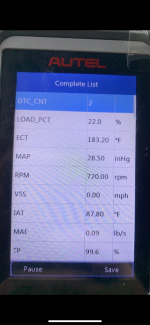Conditions for Setting the DTC
P0102
The ECM detects that the MAF sensor is less than 3.6 g/s for greater than 3 seconds.
DTC P0113
Intake Air Temperature (IAT) Sensor Circuit High Voltage
P0113 is open, short to voltage, or signal performance on the signal wire of the sensor
Circuit/System Description
The intake air temperature (IAT) sensor 1 is a variable resistor that measures the temperature of the air entering the engine. The engine control module (ECM) supplies 5 volts to the IAT signal circuit, and a ground for the IAT low reference circuit. The ECM continuously monitors the IAT sensor 1 signal voltage for an excessively high or low voltage.
Conditions for Running the DTC
The engine is running.
The DTCs run continuously when the above condition is met.
Conditions for Setting the DTC
P0112
The IAT Sensor 1 parameter is warmer than 148°C (299°F) for greater than 1 second. This is equal to or less than 0.10 volt on the IAT signal circuit as measured by the ECM.
P0113
The IAT Sensor 1 parameter is colder than -39°C (-38°F) for greater than 1 second. This is equal to greater than 4.8 volts on the IAT signal circuit as measured by the ECM.
Action Taken When the DTC Sets
DTC P0112 and P0113 are Type B DTCs.
Conditions for Clearing the DTC
DTC P0112 and P0113 are Type B DTCs.
Diagnostic Aids
With the ignition ON and the engine OFF, if the engine is cold, a properly functioning IAT sensor will gradually increase the scan tool IAT Sensor parameter. This is due to the heat that is generated by the mass air flow (MAF) sensor heating elements.
Depending on the ambient temperature, an IAT sensor signal circuit or low reference circuit that is shorted to the MAF sensor signal circuit can cause a DTC P0113 to set. This condition can cause a rapid fluctuation in the IAT Sensor parameter.
An IAT low reference circuit that is open can cause the IAT Sensor parameter response to be sluggish. This condition may not necessarily set a DTC.
An IAT sensor signal circuit that is shorted to the MAF sensor ignition circuit can cause a DTC P0113 to set.
Verify that any electrical aftermarket devices are properly connected and grounded. Refer to Checking Aftermarket Accessories.
Circuit/System Verification
Engine running, observe the scan tool IAT Sensor 1 parameter. The reading should be between -38 to +148°C (-36 to +298°F) depending on the current ambient temperature and the vehicle operating conditions.
Operate the vehicle within the Conditions for Running the DTC. You may also operate the vehicle within the conditions that you observed from the Freeze Frame/Failure Records data.
Circuit/System Testing
Ignition OFF, disconnect the harness connector at the mass air flow MAF/IAT sensor.
Ignition OFF, for 90 seconds, test for less than 5 ohms between the IAT Sensor 1 low reference circuit terminal 4 and ground.
If greater than the specified range, test the IAT Sensor 1 low reference circuit for an open/high resistance. If the circuit tests normal, replace the ECM.
Ignition OFF, test for less than 5 ohms between the MAF sensor low reference circuit terminal 2 and ground.
If greater than the specified range, test the MAF sensor low reference circuit for an open/high resistance. If the circuit tests normal, replace the ECM.
Ignition ON, verify the scan tool IAT Sensor 1 parameter is less than -39°C (-38°F).
If warmer than the specified range, test the signal circuit terminal 5 for a short to ground. If the circuit tests normal, replace the ECM.
Install a 3A fused jumper wire between the signal circuit terminal 5 and a ground. Verify the scan tool IAT Sensor 1 parameter is warmer than 148°C (298°F).
If colder than the specified range, test the signal circuit for a short to voltage or an open/high resistance. If the circuit tests normal, replace the ECM.
If all circuits test normal, test or replace the MAF/IAT sensor.
Component Testing
Measure and record the resistance between the signal terminal 5 and the low reference circuit terminal 4 at the IAT sensor. Compare the value to the Temperature Vs Resistance table. Refer to Temperature Versus Resistance (EGR Temperature Sensors) Temperature Versus Resistance (ECT Sensors) Temperature Versus Resistance (Fuel Temperature Sensor) Temperature Versus Resistance (IAT Sensor 1) Temperature Vers.us Resistance (IAT Sensor 2) Temperature Versus Resistance (EGT Sensors).




